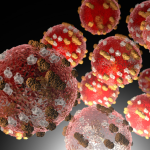This article is a guest post, kindly contributed by Giuliana Furiato.
Measles is a viral illness caused by infection with the measles virus. The first symptoms are fever, then cough, runny nose, and red eyes. It culminates as a rash of tiny, red spots which starting from the head spreads to the rest of the body. Measles virus is highly contagious, and it is transmitted from person to person by respiratory droplets, small particle aerosols, and close contact. In fact, it can stay in the air for up to 2 hours after an infected person has released it.
Despite the ease of contagion, the epidemiology of measles is variable across the globe. But why?
This infection occurs only in humans; animals are not a potential reservoir of infected particles. However, among the human population three different classes of people can be identified: vaccinated, non-vaccinated but infected, non-vaccinated non-infected. The former are protected due to vaccination, the second due to primary infection, but the latter are a potential target for viral particles. In this last group there are people who have not been vaccinated yet (i.e. young infants), and those who can’t receive a vaccine, such as pregnant women and immunocompromised patients.
What is the difference between these three groups? While the first two groups may be healthy carriers and, therefore, contract the virus but not manifest symptoms, the last group manifests typical symptoms that in a minority of cases can be fatal. While healthy people can survive measles infection complications, those who are immunosuppressed and, therefore, have a compromised immune system, are less likely to make a quick recovery. The most common complications are pneumonia or middle-ear infection due to the measles virus itself or a secondary bacterial infection. For pregnant women with measles there is an increased risk of maternal death, spontaneous abortion, and intrauterine foetal death.
Yet, as we said earlier, this virus is only transmitted to humans, so it could be eradicated. How? Through vaccination. In fact, it is estimated that if between 93% and 95% of the population were vaccinated, we could eradicate the disease. WHO’s definition of eradication is:
“The permanent reduction to zero of the worldwide incidence of infection caused by a specific agent as a result of deliberate efforts.”
The vaccine
The vaccine is a live attenuated measles strain, thus is a harmless, less virulent version of the infectious agents. It is usually administered in combination with mumps, and rubella vaccines (i.e. MMR vaccine: measles, mumps, and rubella) and it requires more than one dose to achieve a higher level of protection. According to WHO, in developed countries the first dose should be given at 12 to 15 months and the second at 4 to 5 years.
This vaccine is very effective. In fact, according to data, two doses are about 97% effective at preventing measles if exposed to the virus. One dose is about 93% effective. What does this mean? Those who received two doses of vaccine are at a 97% lower risk of developing disease than the group who don’t receive them.
When can you say you’re protected? To work a vaccine must induce the production of protective antibodies in response to it. Detectable antibodies against the measles vaccine generally appear within just a few days after vaccination. People are usually fully protected after about 2 or 3 weeks. Therefore, the immune systems of vaccinated people exposed to someone with measles remember how to fight off the wild-type virus.
The adverse effects of the measles vaccination are rare and minor and resolve without any specific treatment; indeed, 5% of immunised children experience malaise and fever 1 to 3 weeks following vaccination. No link between receiving vaccines and developing autism spectrum disorder (ASD) has been detected by solid scientific research performed all around the globe including Centres for Disease Control (CDC) and National Academy of Medicine. In contrast, without vaccination, there is a high risk of transmitting the infection to others and inducing life-threatening diseases to those who can’t get vaccinated.
Nevertheless, it is important to make a clarification. Fully vaccinated people are not exempt from measles infection, they can still get measles; however, they are more likely to have a milder illness. Moreover, they are also less likely to spread the disease to other people, including people who can’t get vaccinated because of young age or due to a weakened immune system. To protect such people, we need to reach herd immunity. Herd immunity can be reached when enough people in the population have developed protective antibodies against the virus. Being highly contagious, herd immunity against measles can be achieved mainly through active immunisation. Giving measles vaccine early in life should enable us to decrease the rate of virus circulation and raise the age at which children are infected and, therefore, should be vaccinated. Thus, through a tight immunisation schedule it should be possible to protect the majority of the measles-susceptible population.
The availability of a safe, inexpensive, and effective vaccine might let measles elimination become reality. However, although every region in the world has a measles elimination goal, no region has achieved and sustained elimination. Why? We cannot forget that eradication of a disease is not only dependent on the scientific context. Smallpox and rinderpest eradication required political, economic, and social education efforts to succeed.
Tracking and containment of disease outbreaks require cooperation on an international level. Without cooperation, global health campaigns cannot hope to succeed. Without economic support, crucial resources cannot be mobilised effectively. To all this in recent years has been added an increased mistrust in science, as highlighted by the rise of anti-vaccination sentiment. Eradication campaigns require public trust in science and in global health initiatives, thus it will be crucial to gain and maintain it to guarantee their success.
For more insights and articles, don’t forget to subscribe to our newsletters here. If you’d like to see your piece featured on our site, email vaccinenation@terrapinn.com for more information!
Bibliography
https://www.ncbi.nlm.nih.gov/books/NBK448068/
https://www.cdc.gov/vaccinesafety/concerns/autism.html
https://www.ncbi.nlm.nih.gov/books/NBK554450/
https://asm.org/articles/2020/march/disease-eradication-what-does-it-take-to-wipe-out





